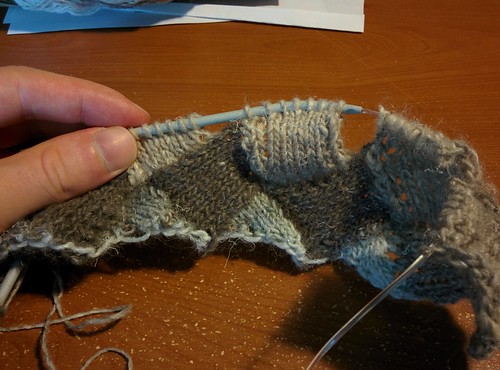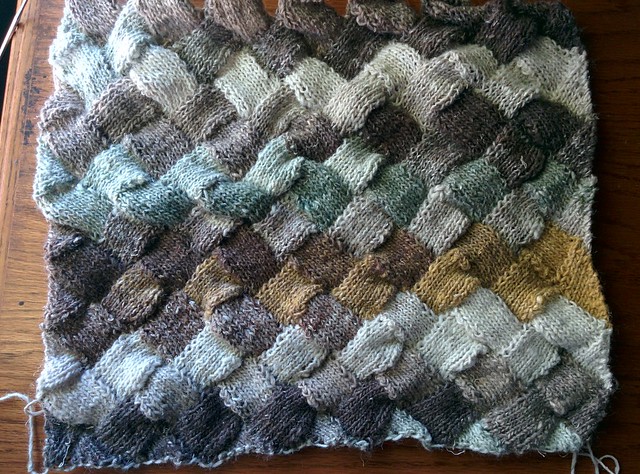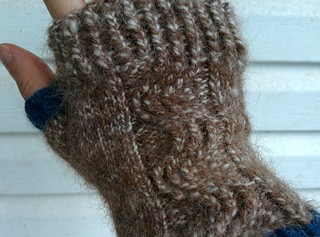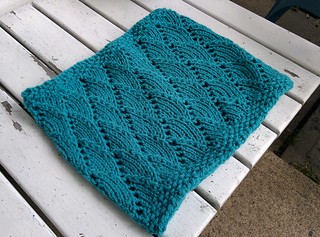Entrelac is my new favourite thing
I knit entrelac now. Entrelac is cool.
You can read the linked Wikipedia article for all the details, but entrelac is basically a knitting technique that involves working a series of rectangles (and triangles) to create a patchwork effect. Instead of knitting across all the stitches on a row, you knit back and forth across a set number of stitches (e.g., groups of 8) over and over. In the process of doing this, you create a slipped stitch edge that you can pick up to create the rectangles on the row above. So as you work one entire "row" or tier of your entrelac project, you get rectangles slanted in one direction and then rectangles slanted in the other direction. Here's what I mean.

I've been admiring an entrelac stole in the local yarn store for a while. Back when I did my baby sweater class, the proprietor gave me the pattern for the stole, and I finally got around to starting it last month. I love challenging myself with my knitting by trying new techniques, and while I didn't anticipate entrelac would be too difficult, I admit to some trepidation. What I did not expect is how much I would absolutely love it.
First, entrelac is dead simple. It's probably one of the easiest techniques I've picked up. If you know how to knit/purl, how to knit/purl stitches together, and how to make new stitches, you're good to go. The only part of the learning curve might be picking up and knitting/purling stitches—but hey, that just gives you practice for turning heels!
Seriously, though, once you get into the rhythm with entrelac, you don't even need a pattern any more, because it is so obvious what you're doing next, even if you've put the project down for days. You can quickly tell at a glance if you've made a mistake, and even if you have 50 or 100 stitches in the entire project, since you're only working a small number of stitches at a time (8, in my case), frogging or ripping out an entire rectangle to fix a mistake is no big deal. Entrelac is a very forgiving technique.
Second, I love the mathematics. I love the mathematics in all of knitting, but especially with entrelac. My pattern calls for 7 blocks of 8 stitches (making 56, yay arithmetic). So everything I do is in 8. I pick up 8, then I knit or purl back and forth until those 8 stitches swallow the next 8 stitches through decreases along the end of each row of the rectangle. At any given time, I know how far I am in the rectangle by how many stitches from the last tier need to be swallowed. As I said above, this makes entrelac an easy pattern to drop and then pick up later.
Third, it's beautiful. Gawk at it!

Finally, entrelac is a happy medium between a technique/pattern that is too boring and one that requires too much attention. I mostly knit in front of the TV or when I'm out socializing. Some patterns require intense concentration: you have to count stitches, rows, and repeats, with or without the help of an aid. And there is nothing wrong with that if you're in the mood for it. Sometimes, though, I just need a project I can do somewhat mindlessly—the trouble is that the very mindlessness of those projects makes them boring, especially if they are larger ones like scarves. As much as I like one-row scarf patterns, I need a little excitement in my life! Entrelac is something that requires a little bit of attention and lets me change up whether I'm knitting or purling, etc., but after a few rows I can quickly sink into the rhythm and just let my hands work while I chill.
I also recently completed a lovely pair of fingerless mittens with a cable pattern. They are mine, for keeping my hands warm when I knit in the winter! And I did a cowl in a whim from some cheap yarn I had lying around; I'm not sure what that is destined for yet.


And that's a knitting update for summer 2016!

